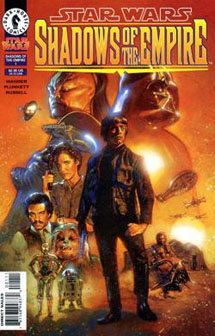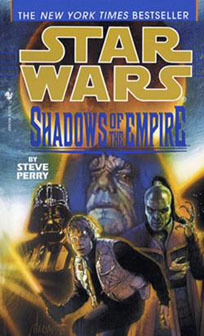While “Shadows of the Empire” hasn’t aged as well as some other “Star Wars” novels and comic books, I have to admit I’ve gone back and reread them a few times now. There’s something kinda fun about this saga-within-a-saga, although I don’t like it as much now as I did in 1996, when I lovingly reviewed the book for a sci-fi class in my freshman year of college (that paper probably could’ve gotten me a job as a Lucasfilm PR flack).
“Shadows” was the first-ever book/comic collaboration and only the second story arc between “The Empire Strikes Back” and “Return of the Jedi.” The first arc came from Marvel Comics, which tapped into some of the same story points, including the Rebels’ acquisition of the Death Star II plans and Boba Fett’s struggles to deliver Han Solo to Jabba the Hutt. However, there was a lot left untouched, and “Shadows” — a novel by Steve Perry and a six-issue series by John Wagner — took advantage of this to reinvigorate the classic trilogy timeline. Interestingly, the pacing and structure (lots of short scenes, not as many long scenes) feels like the George Lucas-penned prequel movies. A lot of “Shadows’ ” appeal is seeing the wider plot points snap into place (Luke constructing his lightsaber, the Rebels getting the plans, Fett delivering Solo, and even Leia acquiring her bounty hunter disguise and a thermal detonator).
But there’s also political intrigue; and the writers do a good job of showing how a black-market enterprise (Black Sun) not only thrives under the Empire, but is in fact one of the Empire’s biggest supporters. And when Perry wrote about Vader trying to breathe without a helmet in his hyperbaric chamber, this was amazing stuff back in 1996, because it was the first time (outside the novelizations, perhaps) that we were privy to the Dark Lord’s thoughts. I like the delicious irony that Vader can use the Dark Side to repair his lungs, but as soon as he’s happy about it (and loses touch with the Dark Side), his progress crumbles.

Prince Xizor, the head of Black Sun, is the standout new character, partly because of his rivalry with Darth Vader, but more so because of the biological makeup of his species, the Falleen. His pheromone-enhanced courtship of Princess Leia is perhaps the raciest stuff in “Star Wars” lore. Although Xizor dies at the end of “Shadows,” “The Clone Wars” animated series later showed that the Falleen as a whole have a substantial presence within Black Sun, and K.W. Jeter would go on to use Xizor and Black Sun to intriguing effect in the “Bounty Hunter Wars” trilogy.
But, for all its strengths, I notice the flaws of “Shadows” more now. Dash Rendar is a decent character: Cynics might say he’s a transparent stand-in for Han Solo, but he’s also a foil for Solo. He only works if he’s paid, he looks out for number one, and he constantly brags about his piloting skills and his ship; basically, he’s Han Solo if Han had never met Luke and Leia. However, he’s way underused in “Shadows,” and he’s killed off so randomly in the final act it’s almost like the writers crumpled up a notebook page and threw it away. The novel “Shadow Games,” set before Episode IV, would finally bring him back in 2011.

The team concept works great for designing the look of this era, as reflected in the comic series illustrated by Killian Plunkett (later of “Clone Wars” fame). But perhaps the writing quality suffers from the fact that Perry and Wagner worked from a boardroom-approved outline. Perry’s novel in particular passes on many opportunities to dig deeper into characters (then again, it’s already a 340-page tome). Perry’s and Michael Reaves’ “MedStar” duology is richer than “Shadows,” but I don’t know if that’s a reflection of Reaves’ talent or of Perry being allowed more free reign.
And although billed as being the essential “interquel” between Episodes V and VI, the story isn’t all that essential. The plot is that Xizor and Vader bicker for the Emperor’s favor like rival siblings (which the Emperor finds amusing); Xizor puts out a bounty for Luke Skywalker dead, Vader posts a bounty for Luke alive. Since we’ve already seen “Return of the Jedi,” it’s not really much of a shock that Vader wins the chess match.
The way Perry and Wagner collaborate is fun, though. We can read the novel to follow the adventures of the major good guys and bad guys, then we can read the comic to not only see the major scenes brought to vibrant life (colorist Cary Porter’s work deserves a nod), but also to get into the deeper shadows. We see the headaches Boba Fett endures from IG-88, Bossk, Zuckuss and 4-LOM, who try to steal the valuable carbonite slab. We also meet Jix, who works for Jabba (who is working for Xizor), but who is truly working for Vader.
More on Jix can be found in the comic one-shot “Shadow Stalker,” and more on Guri — Xizor’s lethal human replica droid — can be found in the comic series “Shadows of the Empire: Evolution.” But that’s about it for the “Shadows” saga. It hasn’t left a huge impact on the lore, in the sense that none of the new characters pop up regularly. On the other hand, it’s a fun yarn, as we get to revisit Luke, Leia, Lando, Chewie, Darth Vader and the Emperor in the heyday of the classic trilogy.

